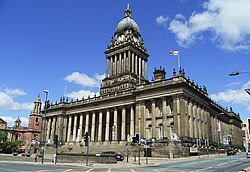Leeds is a city and metropolitan borough in West Yorkshire,England.[4] In 2001 Leeds' main urban subdivision had a population of 443,247,[5] while theentire city had a population of 770,800 (2008 est.).[6] Leeds is the cultural, financial and commercial heart of the West Yorkshire Urban Area,[7][8][9] which at the 2001 census had a population of 1.5 million,[10] and the Leeds city region, an economic area with Leeds at its core, had a population of 2.9 million.[11] Leeds is the UK's largest centre for business, legal, and financial services outside London.



Historically a part of the West Riding of Yorkshire, Leeds can trace its recorded history to fifth century when the Kingdom of Elmet was covered by the forest of "Loidis", the origin of the name Leeds. The name has been applied to many administrative entities over the centuries. It changed from being the appellation of a small manorial borough, in the 13th century, through several reincarnations, to being the name attached to the present metropolitan borough. In the 17th and 18th centuries Leeds became a major centre for the production and trading of wool. Then, during the Industrial Revolution, Leeds developed into a major industrial centre; wool was still the dominant industry but flax, engineering, iron foundries, printing and other industries were important.[12] From being a compact market town in the valley of the River Aire in the 16th century Leeds expanded and absorbed the surrounding villages to become a populous urban centre by the mid-20th century.
The diverse array of landmarks, which includes rural open spaces and impressive buildings, reflects both its industrial past and its many current roles. The multicultural nature of the city is evidenced in the range of religious buildings and cultural festivals present. The city is a major centre of higher education, being the seat of the internationally acclaimed University of Leeds as well as Leeds Metropolitan University and Leeds Trinity University College. The student population has stimulated growth of the nightlife in the city and there are ample facilities for sporting and cultural activities, including classical and popular music festivals, and a varied collection of museums.
Public transport, rail and road communications networks in the region are focused on Leeds and there are a number of twinning arrangements with towns and cities in other countries. Its assigned role in the Leeds City Region partnership recognises the city's importance to regional economic development.



History
Toponomy
The name Leeds derives from "Loidis", the name given to a forest covering most of the kingdom of Elmet, which existed during the 5th century into the early 7th century.[13] Bedestates in the fourteenth chapter of his Historia ecclesiastica, in a discussion of an altar surviving from a church erected by Edwin of Northumbria, that it is located in "...regione quae vocatur Loidis", the region known as Loidis. An inhabitant of Leeds is locally known as aLoiner, a word of uncertain origin.[14]
Economic development
Leeds developed as a market town in the Middle Ages as part of the local agricultural economy. Prior to the Industrial Revolution it had become a co-ordination centre for the making of woollen cloth; with white broadcloth being traded at the Leeds White Cloth Hall.[15] Leeds was handling one sixth of England's export trade in 1770.[16]Growth, initially in textiles, was accelerated by the building of the Aire and Calder Navigation in 1699 and the Leeds and Liverpool Canal in 1816.[17] The railway network constructed around Leeds, starting with the Leeds and Selby Railway in 1834, provided improved communications with national markets and, significantly for its development, an east-west connection with Manchester and the ports ofLiverpool and Hull giving improved access to international markets.[18] Alongside technological advances and industrial expansion, Leeds retained an interest in trading in agricultural commodities, with the Corn Exchange opening in 1864.
Marshall's Mill was one of the first of the many factories that were to be constructed in Leeds from around 1790.[19] In the early years the most significant of the factories were woollen finishing and flax mills; diversifying by 1914 to printing, engineering, chemicals and clothing manufacture.[20] Decline in manufacturing during the 1930s was temporarily reversed by a switch to producing military uniforms and munitions during World War II. However, by the 1970s the clothing industry was in irreversible decline, facing cheap foreign competition.[21] The contemporary economy of Leeds has been shaped by Leeds City Council having the vision of building a '24 hour European city' and a 'capital of the north'.[22] It has developed from the decay of the post-industrial era to become a telephone banking centre, connected to the electronic infrastructure of the modern global economy.[22] There has been growth in the corporate and legal sectors[23] and increased local affluence has led to an expanding retail sector, including the luxury goods market.[24]

No comments:
Post a Comment